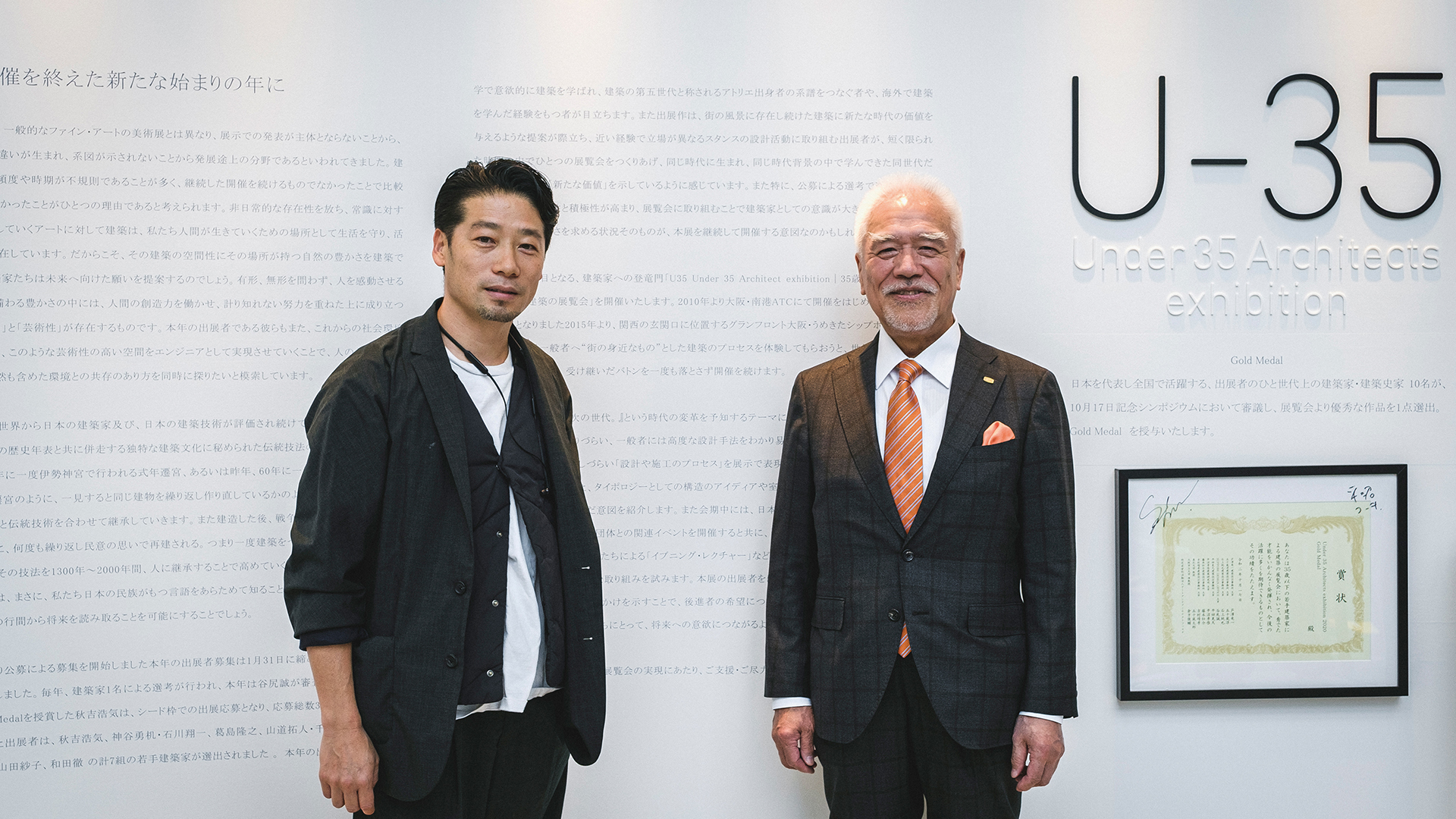
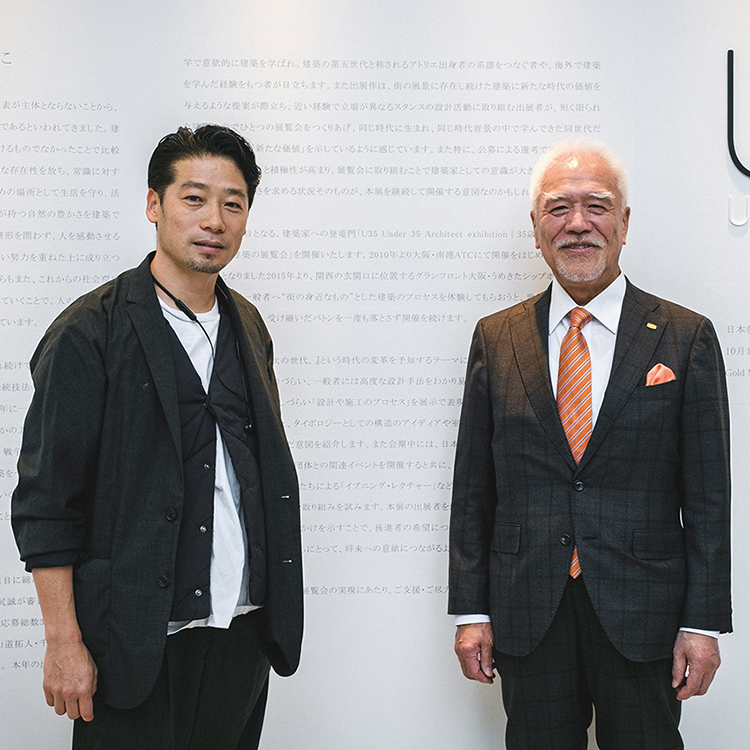


Junzo Tateno
CEO of UNION Corporation
Born in 1947, Junzo Tateno graduated from the Faculty of Law at Konan University (Kobe, Japan) in 1970
and entered Aoki Construction that same year. He joined UNION in 1973 and became CEO and President in 1990.
He serves as Chairman of the Union Foundation for Ergodesign Culture, a Public Interest Incorporated Foundation,
and the Osaka Industrial Bureau. He is also Vice Chairman of the Osaka Chamber of Commerce and Industry.
Makoto Tanijiri
Born in 1974, Makoto Tanijiri is the representative director of SUPPOSE DESIGN OFFICE. He also serves as an Associate Professor at Osaka University of Arts, a Visiting Professor at Hiroshima Jogakuin University, and a Specially Appointed Professor at Anabuki Design College. He runs Sha-Shokudō, Vantage Point Properties, Twenty-first Century Constructions, Mirai Sousaku-jo, Bird bath & KIOSK, tecture, and more. From the perspective of both architect and business proprietor, Makoto Tanijiri works to create new value from various angles and perspectives.
13
TATENO
How old are you now?
TANIJIRI
I’m 46.
TATENO
You’re still so young. I’m 73 now.
TANIJIRI
Is that right? I didn't notice your age at all.
TATENO
Thank you. *Laughs.*
TANIJIRI
President Tateno, what were you doing when you were my age?
TATENO
I engaged in a lot of things I was passionate about. You’ve mentioned in other interviews about taking on a lot of different challenges. I did the same at your age, if I thought there was the slightest potential something would come of it. I made a lot of mistakes as a result as well.
TANIJIRI
That’s part of the process. But by making mistakes, some things in life become clearer.
TATENO
Just making mistakes isn’t good. You also have to put in the effort to make use of those mistakes.
TANIJIRI
That’s very true.
TATENO
How do you think the architecture industry will change moving forward?
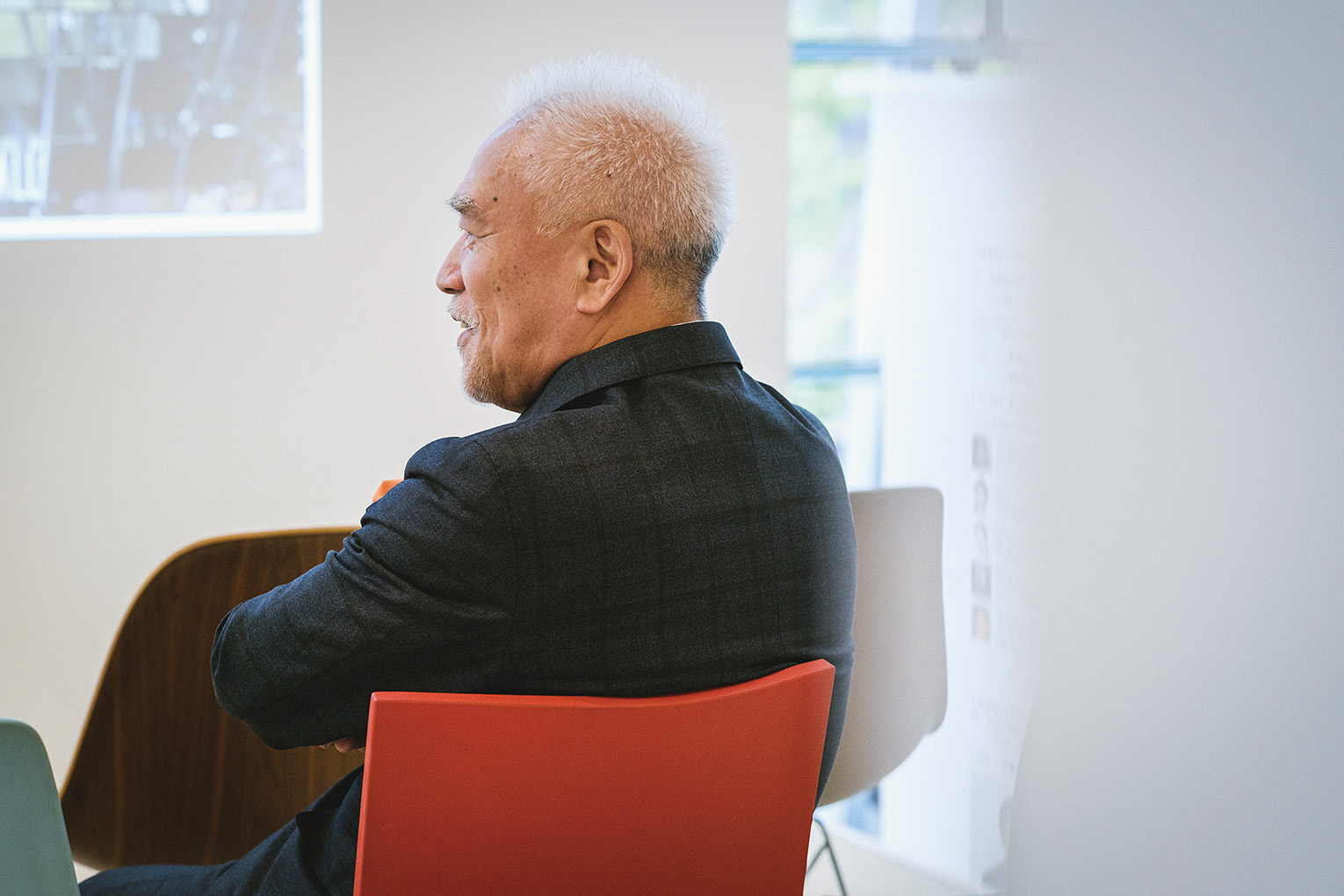
TANIJIRI
I think we are entering a challenging era that will simultaneously bring a lot of things to look forward to.
TATENO
I see. People stagnate if they keep doing the same types of things they’re doing now. I hope things start heading in a good direction.
TANIJIRI
Me too. Of course, I’d like to carry on the architectural traditions established by my predecessors. But rather than simply focusing on inheriting their achievements, it’s essential that we create something new everyday, while thinking about what we need to do to make the present even better. We have to think about what is necessary to improve architecture moving forward.
TATENO
Japanese architecture today is “scrap & build.” We construct something, then tear it down. I think we should have more architectural projects that focus on utilizing existing architecture and transforming them into something new.
TANIJIRI
I agree. Materials are used to make architecture and furniture, so it should be possible to return these structures and objects back to their material form.
TATENO
Right now, UNION is working to create products that use renewable materials. It might cost a little more depending on the material selected, but this is certainly a venture that is in tune with the times. I hope we will be recognized for taking these kinds of initiatives.
TANIJIRI
And in the long run, what you’re doing might be more economical.
TATENO
Take titanium, for example. This might become an actively used building material in the future. We’re also looking at stainless steel, but the problem with it is that it rusts.
TANIJIRI
If titanium became more mainstream, the cost would surely go down as well. Watch us shift from steel-framed structures to titanium-framed structures. *Laughs.*
TATENO
That would be a really luxurious building. *Laughs.* Changing the subject for a second, the Sha-Shokudō project you worked on was really creative and interesting.
TANIJIRI
Thank you. Architectural offices come up with really creative ideas when it comes to architecture. But when it comes to people’s everyday lives, I feel like creativity is a bit lacking. Look at the staff that work at workshops or art studios, for example. They don’t get paid much and don’t really get time off. Some may feel there is no end in sight to their work. This type of situation is not suited to being a functioning part of society. For this project, I put myself in their shoes and, watching the staff eat their convenient store lunches, thought about what I could do to help.
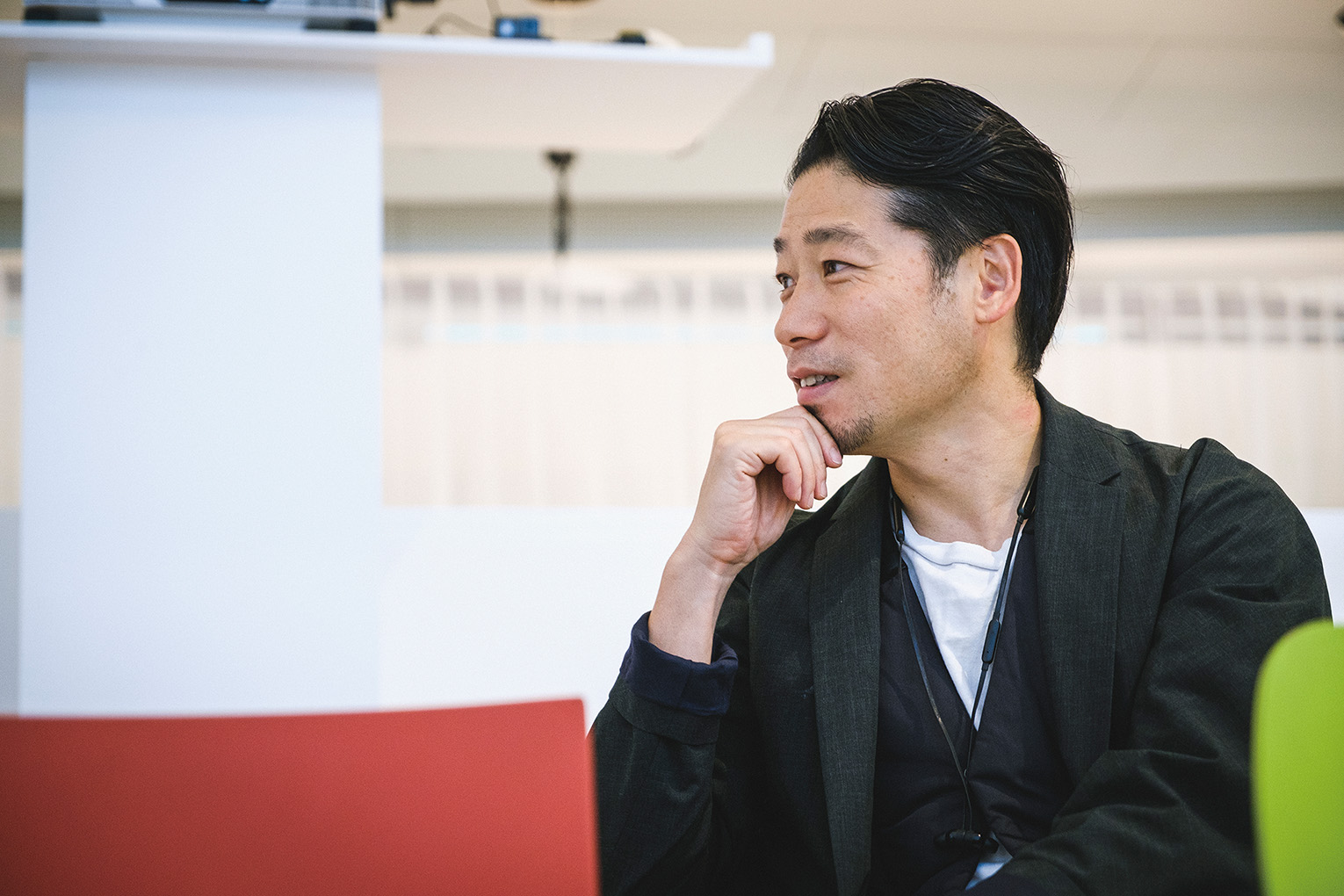
TATENO
People working at these workshops and studios really have hard jobs.
TANIJIRI
That convenient store food is what’s feeding the cells in their bodies. It’s bad for their health and leads to irregular habits. When you’re young you can get over things through sheer will and by powering through them. But when you get older, this lifestyle starts to affect your body, and you can’t work as well as you’d like. This is why I believe that getting your lifestyle in order is one part of your work as an architect or designer.
TATENO
Interesting.
TANIJIRI
In the past, I used to work endless hours and fill myself with convenient store food as well. But at some point, I started to question that lifestyle and felt the need to make a change. This was what inspired me to create Sha-Shokudō.
TATENO
I think it’s really wonderful that an architect such as yourself took on a project like that.
TANIJIRI
Thank you. This is purely a coincidence, but my wife is actually a cook.
TATENO
Is that right?
TANIJIRI
Yes. One day my wife was talking about how food is the raw material that builds our cells. It made quite the impression on me. If the staff at architectural firms are all unhealthy, then that means these firms and offices are built on a foundation of unhealthiness. You can’t come up with good ideas in an environment like that. Taking care of one’s health, then, should lead to a transformation in how we work as well.
TATENO
I couldn’t agree more. We should be spending money on good food from a young age. I believe that good health allows us to acquire a variety of knowledge and sensibilities in the end.
TATENO
What do you think about improving one’s sensibilities?
TANIJIRI
I think that one’s taste and sensibilities are related to the life that they live. People who live good lives become good designers and good architects, don’t you think? If you are aware of your life and lifestyle, then that will feed back into your drawings and designs. People whose lives are out of control have no way of creating great designs.
TATENO
I see.
TANIJIRI
For Sha-Shokudō, I thought about what types of things are fun to do during meals as well as about how to encourage conversation. What type of space with what type of lighting and what types of colors would best match this purpose? I considered these questions as the design came to life. Being aware of the various fragments that make up our daily lives is a big part of design.
TATENO
My generation never really thought about things like that. All that mattered was how hard you worked. At times men thought little about their families. But that was wrong. Like you said, the most important thing is to make time for your life and then concentrate on your work within that framework. If you become too focused on one thing or the other, things fall out of balance.
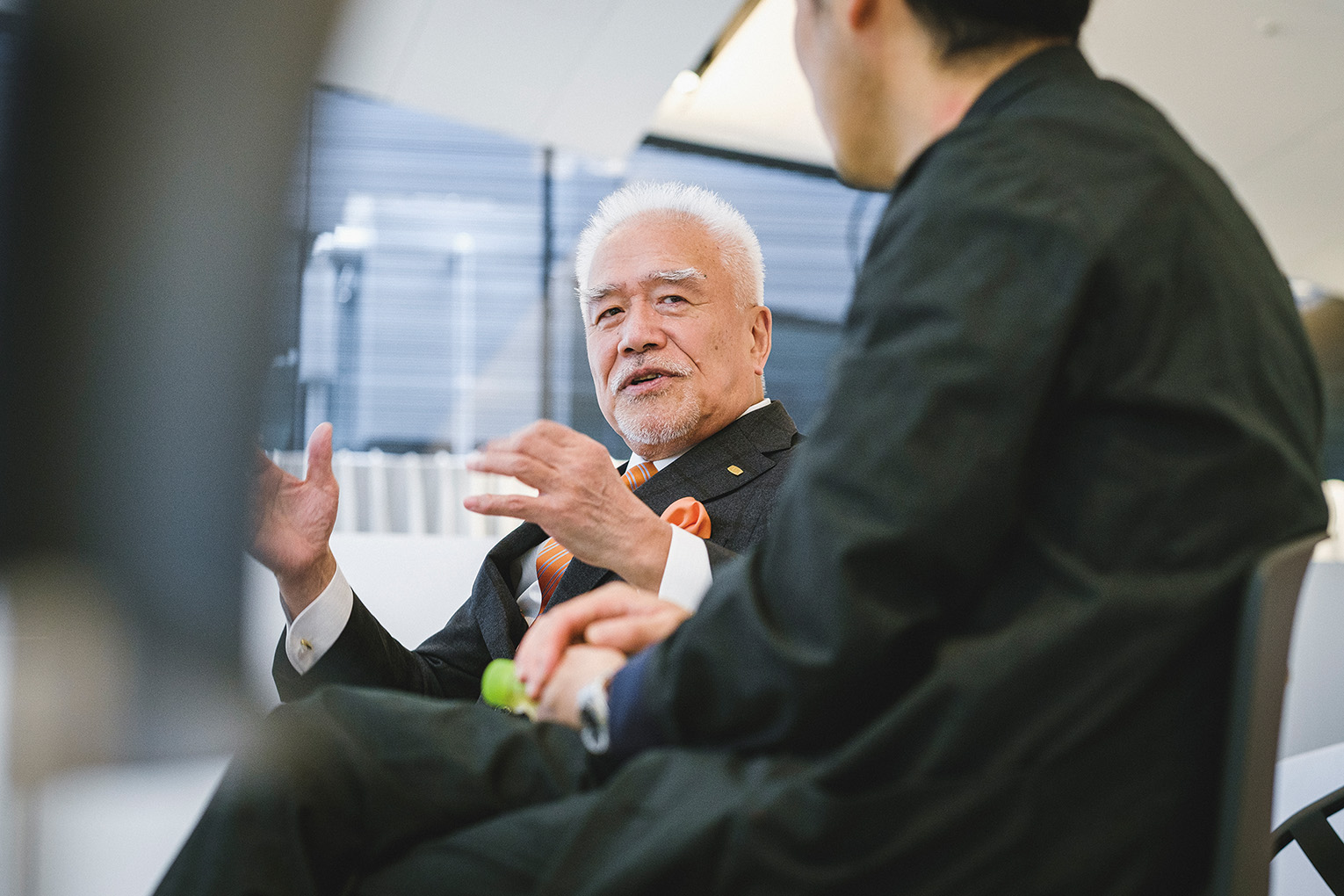
TANIJIRI
Particularly since corona, there are more hours in the day when it is unclear whether we are working or simply living. I think this presents a conflict between work and having a fulfilling life when these lines become blurred.
TATENO
Working remotely allows us to do our job without going to the office. I think the only people who can maintain the same level of performance in an environment like this are the truly gifted. Our company trades in a lot of products that were manually crafted so working together in person is extremely important.
TANIJIRI
That’s true. If you don’t look at a product firsthand, you won’t be able to check things like its texture. It’s also hard to get a sense of a space in terms of its smells and atmosphere through a photograph.
TATENO
Corona really did change everything, didn’t it?
TANIJIRI
It did. It really has subverted people’s desires to start up all kinds of new businesses.
TATENO
Very true. I’ve heard a lot of stories about new business plans that were underway that suffered a big setback due to corona.
TANIJIRI
Architects generally have to wait for work to come to them. Someone has to start up a business or build a house or make some other kind of proactive effort for the architect to get work. I fear that if people stop taking action, then the opportunities available to architects will be fewer and fewer. That said, I also believe that special circumstances such as this afford us the chance to create our own work as architects. Society will never be completely lacking in opportunity, so there is still room for us to take action ourselves.
TATENO
At UNION, as part of our effort to promote the SDGs, we strive to use as many natural materials in our products as possible. We’ve been taking a renewable approach to our work.
TANIJIRI
I was born and raised in the basin city of Miyoshi, Hiroshima. I grew up surrounded by rivers. It was the type of environment where you could go fishing everyday. Up until recently, my architectural work has focused on metropolitan areas, but I’ve started thinking about how I could work more directly with nature. I wouldn’t devote the majority of my life to this, but I am thinking about how I could be more involved with natural settings in my job.
TATENO
That sounds great. There are ways to renovate and revitalize old traditional Japanese houses, rather than simply tearing them down. You could also reuse the materials used to construct these houses. Do you think this type of approach will increase in the future?
TANIJIRI
I think it will.
TATENO
I think traditional Japanese homes are really exceptional. France’s culture for building stone houses is also fantastic, but there is something about the wooden structures built in Japan that just feels good for one’s health.
TANIJIRI
I haven’t had the opportunity to design a Japanese-style room up until now, but I’ve become increasingly attracted to these rooms recently. When you enter one, you suddenly realize you too are part of the surrounding space. I’d like to design a room with a slightly dark interior looking onto a bright garden. I spent my childhood in a traditional Japanese townhouse without any air conditioning. Instead, we would sprinkle water on the ground and get a good breeze blowing through the house. It was dark inside but bright outside. I don’t know if it’s because of these early childhood memories, but I feel like this old-fashioned way of life might be just what we need today.
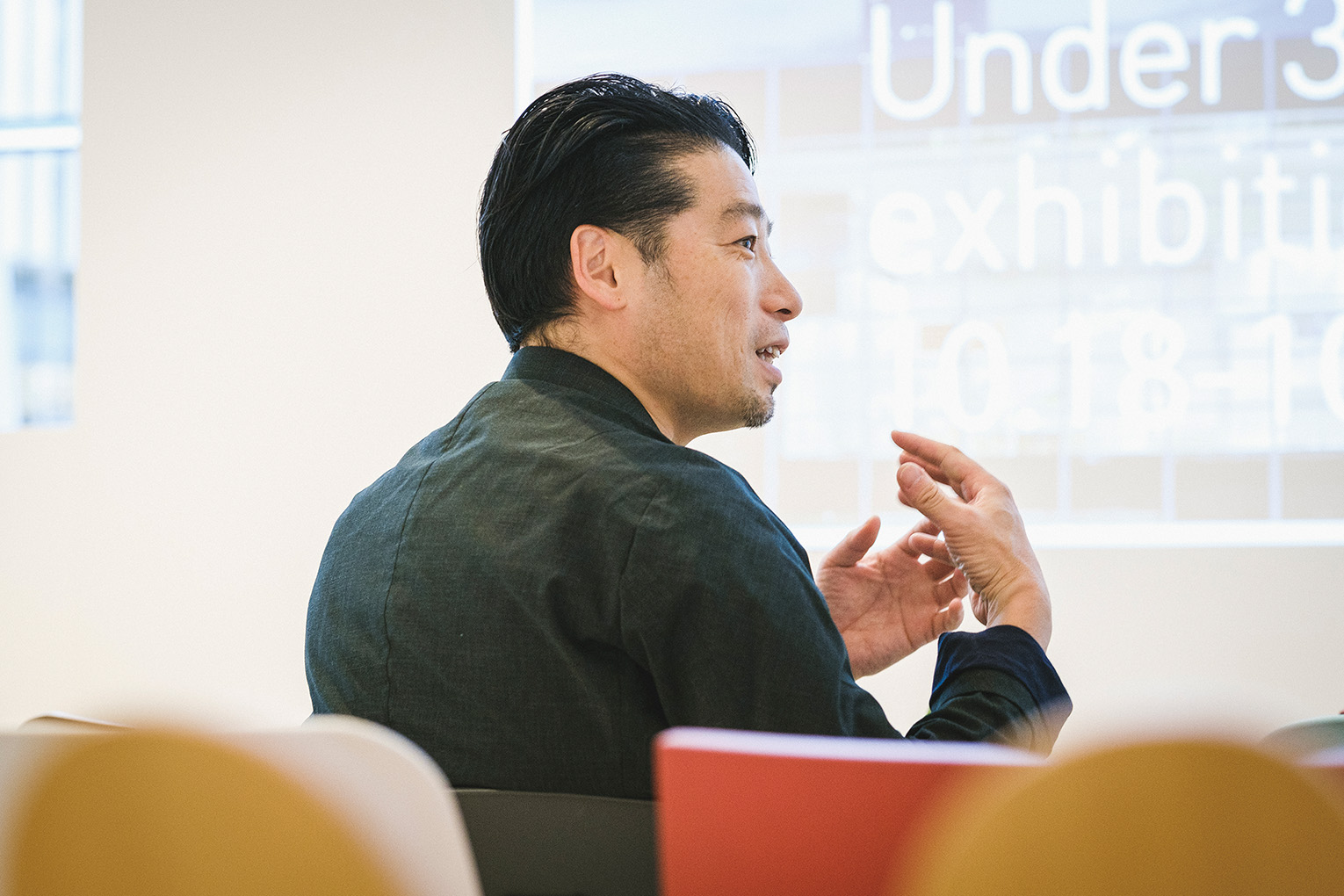
TATENO
This lifestyle you’ve been talking about is full of all the things that make Japan great. Rather than returning to that way of life, I believe my life would be richer if I found a way to integrate these elements into my current lifestyle.
TANIJIRI
Bringing the old back into modern life might just be new in and of itself.
TATENO
I used to live in a house made in the Sukiya-zukuri style.
TANIJIRI
Is that right?
TATENO
Traditional Japanese housing has a way of naturally circulating air through it. The best part is this gives you a sense of the seasons. It used to be cool in the summer in Japan.
TANIJIRI
I long for that kind of lifestyle. Recently, when I take a trip somewhere, I always choose a traditional Japanese-style inn over a hotel. When you stay in a Japanese inn, you can spend time in a more relaxed state of mind. Sitting on the tatami drinking a cup of tea is a moment of pure bliss. It always reminds me of what it is to be Japanese.
TATENO
Now, I live in an apartment, but there are times when I just can’t relax. There’s nothing better than lying down on a tatami floor when you want to take it easy.
TATENO
Is there anything that you really tend to focus on in your architecture? Sometimes there are situations where we have to convince a client about something we want to do and press forward.
TANIJIRI
I think I'm a rather flexible person. I don’t have any particularly strong preferences in carrying out my work. That does not mean I’m okay with anything, though. It just means I am not interested in creating something to the point that it would hinder my life. Ideally, when your life is in order then so too will your work come together. Until now, what we value in a given work and what we value in life have been at odds. I continue to wonder whether there is anything that has achieved a balance between both.
TATENO
You really place importance on people’s lives, don’t you? You’re consistent about that. Do you go through a lot of discussions when making a private residence?
TANIJIRI
I do. First, I make sure to visit the client at their home. We talk things over, and I learn what they value in life. I find out things like what type of clothes they wear, what kinds of flowers they decorate their house in, and whether they are tidy or not. When drawing up a design, it’s important to imagine what the structure will look like and what the inhabitants’ lives will be like one year after completion. This is true regardless of how cool a picture you can take of the building when it is first completed. Architecture begins after the structure is erected; it doesn’t end when construction is finished. I try to keep this in mind when I design a project.
TATENO
There are a lot of architectural works that grow in character with the passage of time, after the project’s completion.
TANIJIRI
Exactly. This is why I avoid painting the buildings I work on as much as possible. Even plasterboard has its own unique color. Every material has its own color. I’ve started to believe that the natural way to use a material is to keep it just as it is. Of course, I don’t leave everything unpainted. At some point, I just stopped trying to paint everything.
TATENO
Sometimes the cracks in a building really suit it. Of course, that’s as long as they don’t impede peoples’ lives.
TANIJIRI
That’s true. I’ve started to think seriously about whether I can make structures that bloom with new potential years after they are completed.
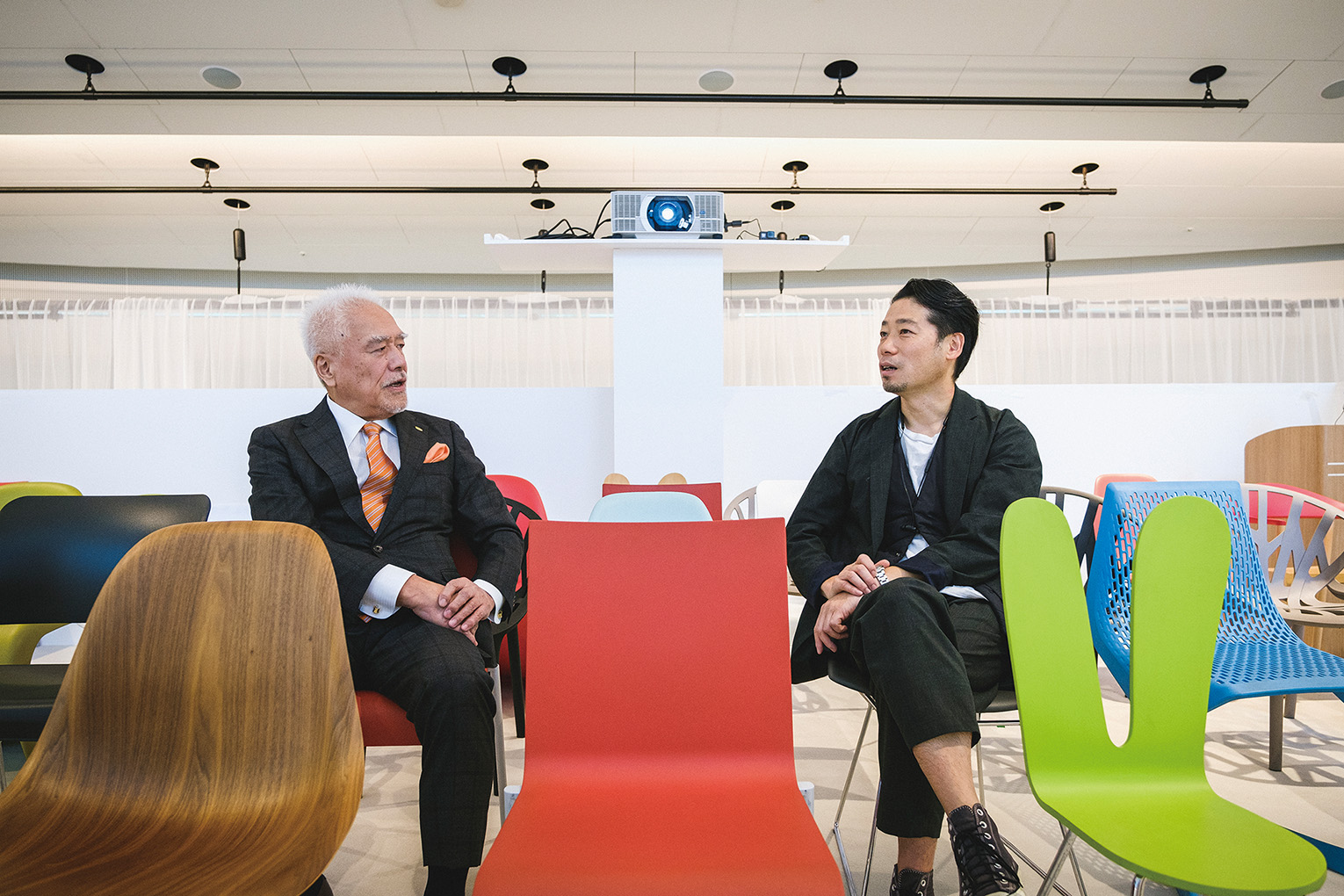
TATENO
That’s great. It is true there’s a chance that this way of thinking can lead to complaints if not properly understood. I hope more people begin to recognize this type of vision. I really hope young people start to take on various new challenges that will allow for the further development of technologies for producing building materials. UNION’s products now use a lot of ready-made items. This might make our jobs easier, but doing the same thing over and over does not produce interesting results. The same can be said for architecture.
TANIJIRI
Yes, architecture is the same. There’s no guarantee that something highly valued now will maintain the same worth ten years down the line.
TATENO
I think architecture is an industry where technology grows through dedication and discipline. Working hard to meet the, at times, unreasonable requests of architects has led to the current technologies we have at UNION, for example.
TANIJIRI
Challenging oneself is important. Even making a mistake can lead to new advancements. I hope to continue challenging myself moving forward.
TATENO
You must have faced a lot of difficulties up until now, no?
TANIJIRI
I have. But looking back on these challenges, I see them as nothing more than positive episodes in my life. I’ve received various complaints, but have taken them head on and, in the end, gotten back on good terms with the client. If you take a sincere approach to your work, you can reach an understanding. Sometimes the complaints aren’t about the building, but have to do with a certain response the client was unhappy about. Once I understood that complaints come from some form of dissatisfaction with one thing or another, I started to make a conscious effort to improve things like communication and project management, rather than simply focusing on the building itself.
TATENO
So even though you’ve been through a lot of challenges and made a lot of mistakes in the process, you’ve converted all these experiences into something positive in the end.
TANIJIRI
I guess I have a penchant for doing that. Of course, I’ve had my share of difficulties just like anyone else. *Laughs.* But I see these difficulties as a plus. I tell my staff all the time to try and avoid making mistakes, but if you are going to make one, make sure you really challenge yourself in the process. I want them to make bold, not boring mistakes, so they can get something out of the experience.
TATENO
Saying that must make it really easy for your younger staff to take on new challenges.
TANIJIRI
To be honest, I don’t think many big mistakes will occur to begin with. When dealing with a product like those made by UNION, it would be a big issue if there was a problem with a ready-made part, and the product got out into the market. The products we deal in, on the other hand, are single, giant structures, so there is no way a building will be handed over to someone we don’t know without our knowledge. To put it another way, our job is to work directly with the object right in front of us. There are almost no instances where a single problem has gotten so out of hand that there was nothing we could do to fix it. This is why I think architecture is a profession where one can take bold challenges.
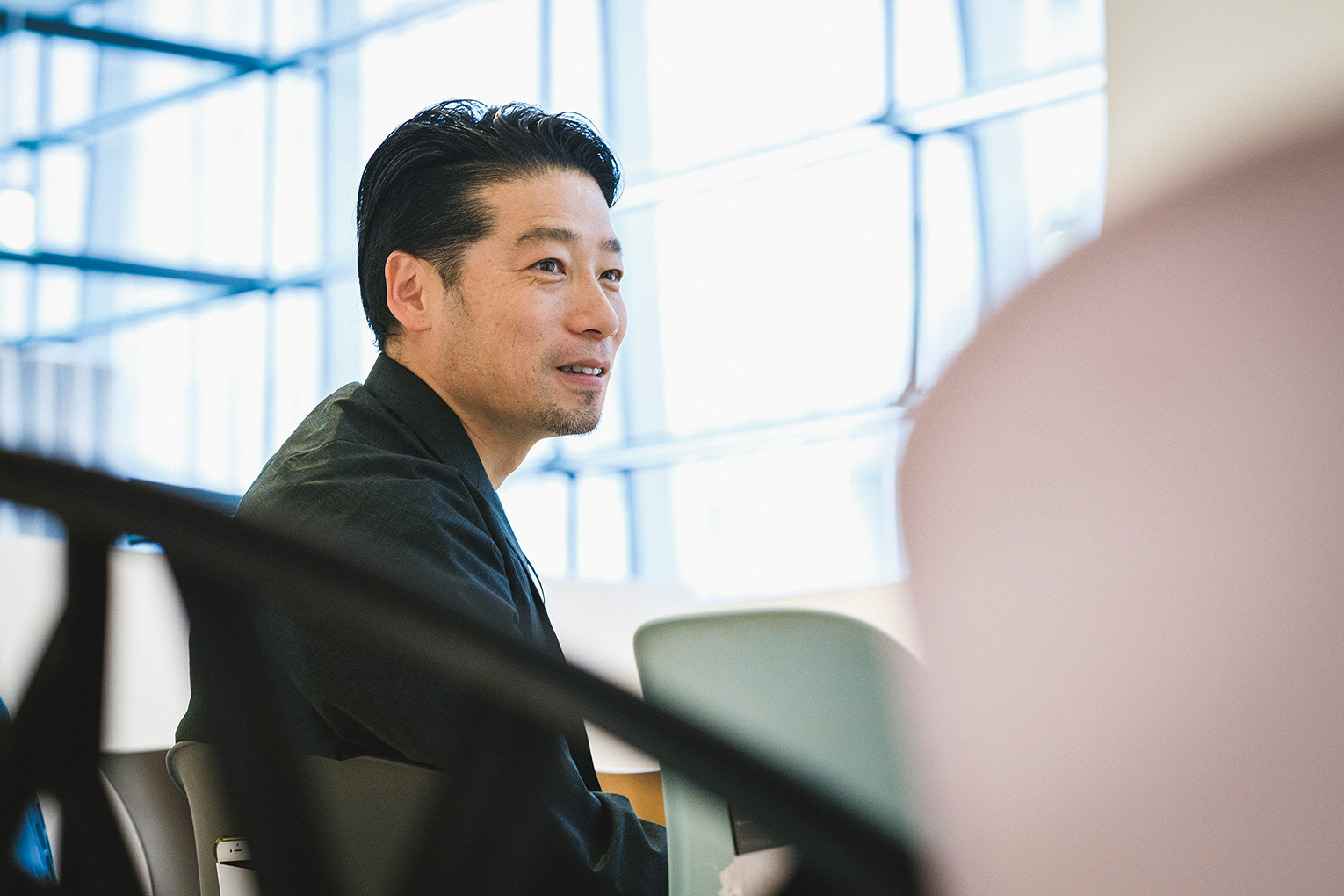
TATENO
There’s something romantic about being an architect. The objects you imagine come to life and are left standing for decades at a given site.
TANIJIRI
It’s very interesting and fun work.
TATENO
What was your reason for deciding to become an architect?
TANIJIRI
My parent’s house was an old traditional machiya. When I was growing up I used to take a bath in an outdoor wooden tub that was heated directly from below. On rainy days, I would have to carry an umbrella with me as I walked back and forth between the bath and house. I really hated that. No other kids I went to school with had to collect firewood to heat their bath.
*Laughs.*
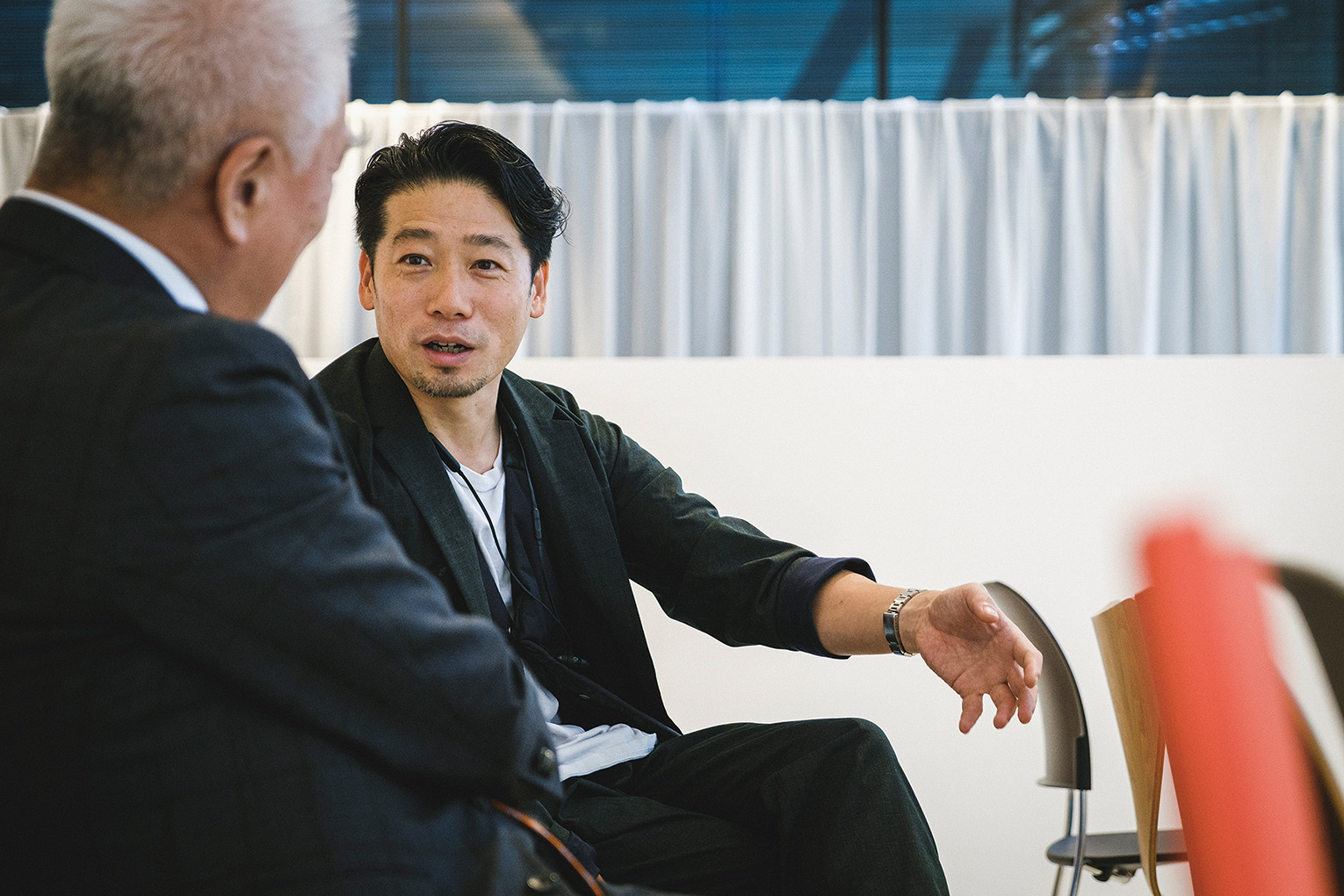
TATENO
*Laughs.*
TANIJIRI
After going through an experience like that, I began saying from a young age that I wanted to build houses that were easy for people to live in. Now, I look back on that life and think it was really special in its own way. You could say that I decided to become an architect due to these bad experiences in my childhood, but now these events have become a big part of how I design a project. It’s really strange how things change like that.
TATENO
That’s wonderful that you made an occupation out of what you dreamed about as a kid.
TANIJIRI
In the end, I don’t know how well-suited I am for this job, but I really enjoy it, so I’m glad I set out to become an architect.
TATENO
All architects have something that inspired them to take up the profession. Whether speaking of Tadao Ando or Toyo Ito, they each had their own reason for becoming an architect. I’m rather envious of that. I inherited my position.
TANIJIRI
I think it’s really difficult to be handed down a position like that. You have to carry on in the traditions of your predecessors, while creating new value at the same time. That’s tough.
TATENO
After working at this job, one thing I realized was that the action of creating something is fun.
TANIJIRI
It really is. I am constantly reminded of how interesting the creative process is in my work.
TATENO
Sou Fujimoto was appointed as expo site design producer for Expo 2025 Osaka, wasn’t he? It would be great if young architects got involved in the design of the pavilions.
TANIJIRI
It sure would. It would be interesting if this event became a chance for young architects to show what they’ve got.
TATENO
For the previous World Expo held in Osaka, architects Kenzo Tange and Kisho Kurosawa took an active role in designing it. Kisho Kurosawa was just 30 years old at the time.
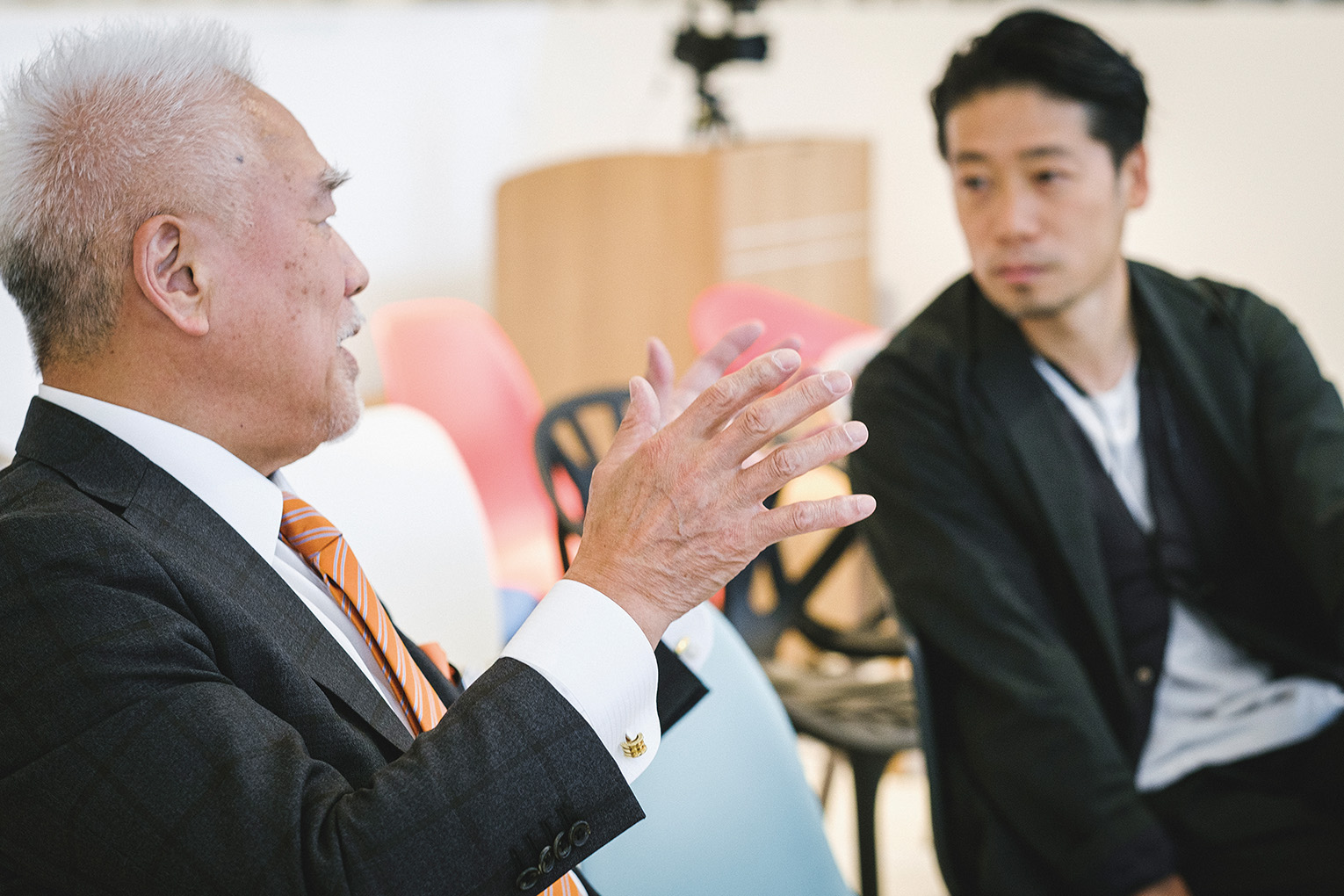
TANIJIRI
That’s right. I’m really looking forward to Osaka’s next World Expo. I’m sure the world will be quite different in 2025.
TATENO
I hope we will see some truly magnificent and groundbreaking things that take a futuristic approach to the subject at hand.
TANIJIRI
There is a requirement to present something that is suggestive of the future to come.
TATENO
The reason why I think it would be great for the World Expo to offer young architects the chance to take an active role is because I believe it is important to get a taste of success in one’s career. The world should be one where architects are able to make money and live through doing architectural work.
TANIJIRI
I agree. I want to create a society where everyone can make a living for themselves.
TATENO
Is that right?
TANIJIRI
This year I started a project where I interview various architects and release the results of these interviews out into the world.
TATENO
Wow, you’re still young but have already started this type of work. Are you in the position to start cultivating the next generation of architects?
TANIJIRI
I hate thinking about things just in terms of how they benefit me. This spring I launched TECTURE MAG, which is a new form of daily media for communicating information on architecture and various other works.
TATENO
What kind of media is this exactly?
TANIJIRI
It’s the next generation of design media. It integrates traditional media with a search function service, which is what sets it apart from conventional types of media. If you click on where it says “PROJECT,” various architectural works and spaces will be displayed. A yellow circle will then appear within the picture you select. If you click on this, it will instantly tell you what types of materials were used in the area selected.

TATENO
This is amazing. It even tells you the name of the manufacturer.
TANIJIRI
That’s right. It also provides you with the parts number and a link to the manufacturer’s website.
TATENO
Manufacturers must be really happy about this.
TANIJIRI
Actually, a lot of manufacturers don’t know where the products they supplied were finally used. They often don’t have any photographs showing examples of their products in real-world settings.
TATENO
I’m familiar with this. At UNION, we don’t know where all of our handles are currently being used.
TANIJIRI
We’ve also developed an additional service called TECTURE. With this, you can access product information for furniture and building materials through actual design examples. This service even allows you to contact the manufacturer directly. Building on this functionality, you can also hover your camera over the page and acquire product data for the items pictured.
TATENO
That is really convenient. Using this will allow an even larger number of people to discover products like ours.
TANIJIRI
When you place an ad in a magazine, there’s no way of knowing who’s actually looking at it. This is why we’ve decided to combine information with the manufacturer to eliminate the time it takes to do a search online. Architects are always looking for manufacturers when they flip through magazines, so this saves them time when having to search for a specific product.
TATENO
I see.
TANIJIRI
The time they save can then be spent on more creative pursuits. I’m hoping this will help to reduce the pervasively long working hours in this industry.
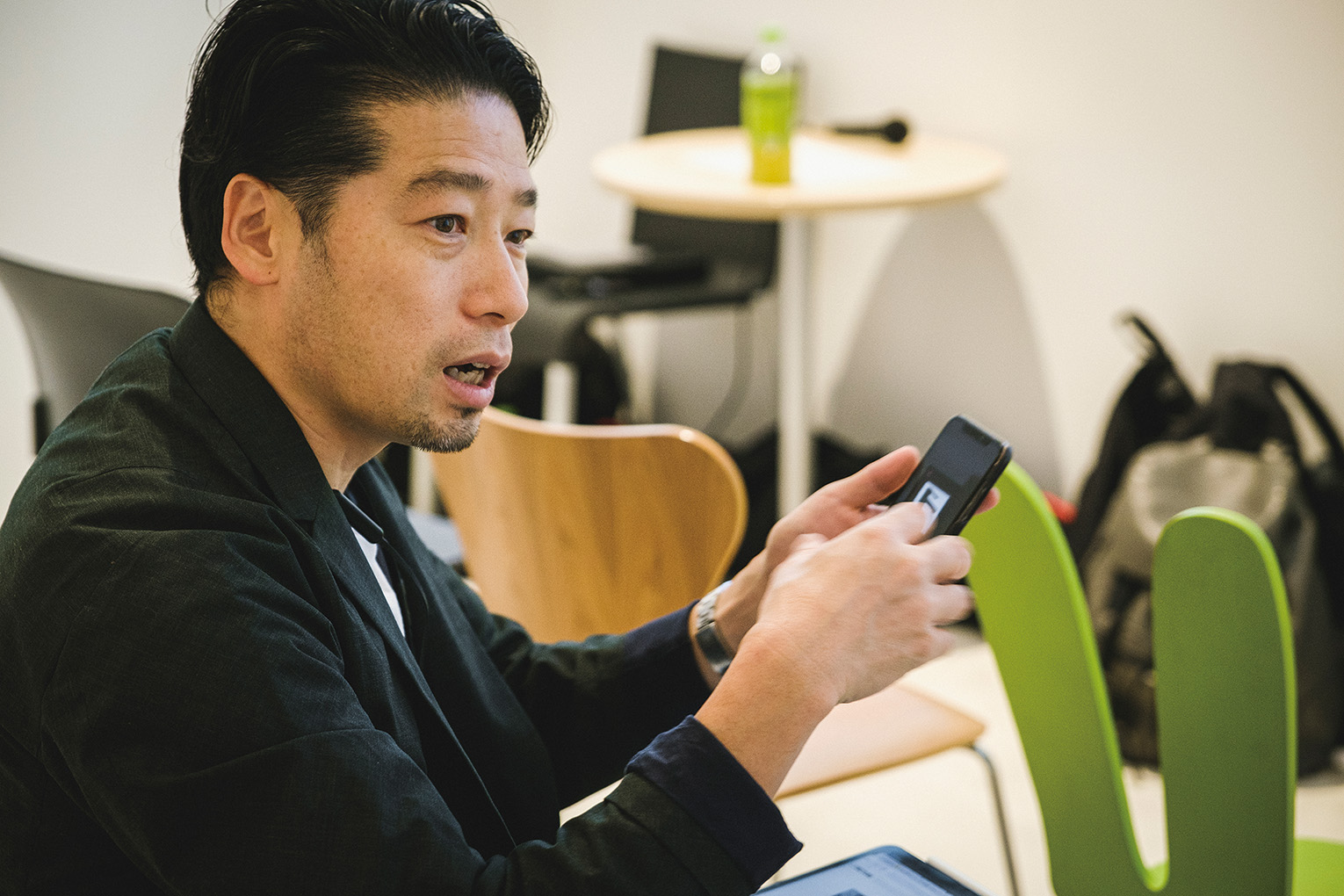
TATENO
That’s a great endeavor.
TANIJIRI
It’s a project unlike any other I have taken on before. Around 100 manufacturers have already registered with us.
TATENO
So it’s a new challenge for you. Let me know if there is anything I can do to help.
*Interview concludes*
Both
Thank you very much.
Planning: Naoyuki Miyamoto
Photography: Kesuke Kitaura
Writing: Fumiya Daito
Web Direction: Ryo Kijima